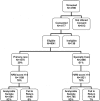Primary versus specialty care outcomes for depressed outpatients managed with measurement-based care: results from STAR*D
- PMID: 18247097
- PMCID: PMC2324144
- DOI: 10.1007/s11606-008-0522-3
Primary versus specialty care outcomes for depressed outpatients managed with measurement-based care: results from STAR*D
Abstract
Background: Whether the acute outcomes of major depressive disorder (MDD) treated in primary (PC) or specialty care (SC) settings are different is unknown.
Objective: To compare the treatment and outcomes for depressed outpatients treated in primary versus specialty settings with citalopram in the Sequenced Treatment Alternatives to Relieve Depression (STAR*D) study (www.star-d.org), a broadly inclusive effectiveness trial.
Design: Open clinical trial with citalopram for up to 14 weeks at 18 primary and 23 specialty sites. Participants received measurement-based care with 5 recommended treatment visits, manualized pharmacotherapy, ongoing support and guidance by a clinical research coordinator, the use of structured evaluation of depressive symptoms and side effects at each visit, and a centralized treatment monitoring and feedback system.
Participants: A total of 2,876 previously established outpatients in primary (n = 1091) or specialty (n = 1785) with nonpsychotic depression who had at least 1 post-baseline measure.
Measurements and main results: Remission (Hamilton Depression Rating Scale for Depression [Hamilton] or 16-item Quick Inventory of Depressive Symptomatology-Self-Rated [QIDS-SR(16)]); response (QIDS-SR(16)); time to first remission (QIDS-SR(16)). Remission rates by Hamilton (26.6% PC vs 28.0% SC, p = .40) and by QIDS-SR(16) (32.5% PC vs 33.1% SC, p = .78) and response rates by QIDS-SR(16) (45.7% PC vs 47.6% SC, p = .33) were not different. For those who reached remission or response at exit, the time to remission (6.2 weeks PC vs 6.9 weeks SC, p = .12) and to response (5.5 weeks PC vs 5.4 weeks SC, p = .97) did not differ by setting.
Conclusions: Identical remission and response rates can be achieved in primary and specialty settings when identical care is provided.
Figures



Similar articles
-
Evaluation of outcomes with citalopram for depression using measurement-based care in STAR*D: implications for clinical practice.Am J Psychiatry. 2006 Jan;163(1):28-40. doi: 10.1176/appi.ajp.163.1.28. Am J Psychiatry. 2006. PMID: 16390886 Clinical Trial.
-
The impact of chronic depression on acute and long-term outcomes in a randomized trial comparing selective serotonin reuptake inhibitor monotherapy versus each of 2 different antidepressant medication combinations.J Clin Psychiatry. 2012 Jul;73(7):967-76. doi: 10.4088/JCP.11m07043. Epub 2012 May 29. J Clin Psychiatry. 2012. PMID: 22687487 Clinical Trial.
-
Treatment outcomes for older depressed patients with earlier versus late onset of first depressive episode: a Sequenced Treatment Alternatives to Relieve Depression (STAR*D) report.Am J Geriatr Psychiatry. 2008 Jan;16(1):58-64. doi: 10.1097/JGP.0b013e31815a43d7. Am J Geriatr Psychiatry. 2008. PMID: 18165462
-
A direct comparison of presenting characteristics of depressed outpatients from primary vs. specialty care settings: preliminary findings from the STAR*D clinical trial.Gen Hosp Psychiatry. 2005 Mar-Apr;27(2):87-96. doi: 10.1016/j.genhosppsych.2004.10.003. Gen Hosp Psychiatry. 2005. PMID: 15763119
-
Novel Augmentation Strategies in Major Depression.Dan Med J. 2017 Apr;64(4):B5338. Dan Med J. 2017. PMID: 28385173 Review.
Cited by
-
NMDA Receptor Activity in Neuropsychiatric Disorders.Front Psychiatry. 2013 Jun 10;4:52. doi: 10.3389/fpsyt.2013.00052. eCollection 2013. Front Psychiatry. 2013. PMID: 23772215 Free PMC article.
-
Standardized Versus Tailored Implementation of Measurement-Based Care for Depression in Community Mental Health Clinics.Psychiatr Serv. 2022 Oct 1;73(10):1094-1101. doi: 10.1176/appi.ps.202100284. Epub 2022 May 11. Psychiatr Serv. 2022. PMID: 35538748 Free PMC article.
-
STAR*D: revising conventional wisdom.CNS Drugs. 2009 Aug;23(8):627-47. doi: 10.2165/00023210-200923080-00001. CNS Drugs. 2009. PMID: 19594193
-
Stigma towards opioid use disorder in primary care remain a barrier to integrating software-based measurement based care.BMC Psychiatry. 2023 Oct 24;23(1):776. doi: 10.1186/s12888-023-05267-w. BMC Psychiatry. 2023. PMID: 37875835 Free PMC article.
-
Clinical relevance of vilazodone treatment in patients with major depressive disorder: categorical improvement in symptoms.Prim Care Companion CNS Disord. 2014;16(1):PCC.13m01571. doi: 10.4088/PCC.13m01571. Epub 2014 Jan 30. Prim Care Companion CNS Disord. 2014. PMID: 24940525 Free PMC article.
References
-
- {'text': '', 'ref_index': 1, 'ids': [{'type': 'DOI', 'value': '10.1016/0163-8343(89)90040-6', 'is_inner': False, 'url': 'https://doi.org/10.1016/0163-8343(89)90040-6'}, {'type': 'PubMed', 'value': '2721942', 'is_inner': True, 'url': 'https://pubmed.ncbi.nlm.nih.gov/2721942/'}]}
- Williamson PS, Yates WR. The initial presentation of depression in family practice and psychiatric outpatients. Gen Hosp Psychiatry. 1989;113188–93. discussion 216–121. - PubMed
-
- {'text': '', 'ref_index': 1, 'ids': [{'type': 'DOI', 'value': '10.1016/S0163-8343(96)00062-X', 'is_inner': False, 'url': 'https://doi.org/10.1016/s0163-8343(96)00062-x'}, {'type': 'PubMed', 'value': '8937906', 'is_inner': True, 'url': 'https://pubmed.ncbi.nlm.nih.gov/8937906/'}]}
- Schwenk T, Coyne J, Fechner-Bates S. Differences between detected and undetected depressed patients in primary care and depressed psychiatric patients. Gen Hosp Psychiatry. 1996;18:407–15. - PubMed
-
- {'text': '', 'ref_index': 1, 'ids': [{'type': 'DOI', 'value': '10.1097/00005650-199401000-00002', 'is_inner': False, 'url': 'https://doi.org/10.1097/00005650-199401000-00002'}, {'type': 'PubMed', 'value': '8277799', 'is_inner': True, 'url': 'https://pubmed.ncbi.nlm.nih.gov/8277799/'}]}
- Cooper-Patrick L, Crum RM, Ford DE. Characteristics of patients with major depression who received care in general medical and specialty mental health settings. Med Care. 1994;32(1)15–24. - PubMed
-
- {'text': '', 'ref_index': 1, 'ids': [{'type': 'DOI', 'value': '10.1001/archfami.4.2.99', 'is_inner': False, 'url': 'https://doi.org/10.1001/archfami.4.2.99'}, {'type': 'PubMed', 'value': '7842160', 'is_inner': True, 'url': 'https://pubmed.ncbi.nlm.nih.gov/7842160/'}]}
- Simon GE, VonKorff M. Recognition, management, and outcomes of depression in primary care.[comment]. Arch Fam Med. 1995;4(2)99–105. - PubMed
-
- {'text': '', 'ref_index': 1, 'ids': [{'type': 'DOI', 'value': '10.1007/BF02602759', 'is_inner': False, 'url': 'https://doi.org/10.1007/bf02602759'}, {'type': 'PubMed', 'value': '8770718', 'is_inner': True, 'url': 'https://pubmed.ncbi.nlm.nih.gov/8770718/'}]}
- Simon GE, Lin EH, Katon W, et al.. Outcomes of "inadequate" antidepressant treatment.[comment]. J Gen Intern Med. 1995;10(12)663–70. - PubMed
Publication types
MeSH terms
Substances
Grants and funding
LinkOut - more resources
Full Text Sources
Medical
Research Materials

